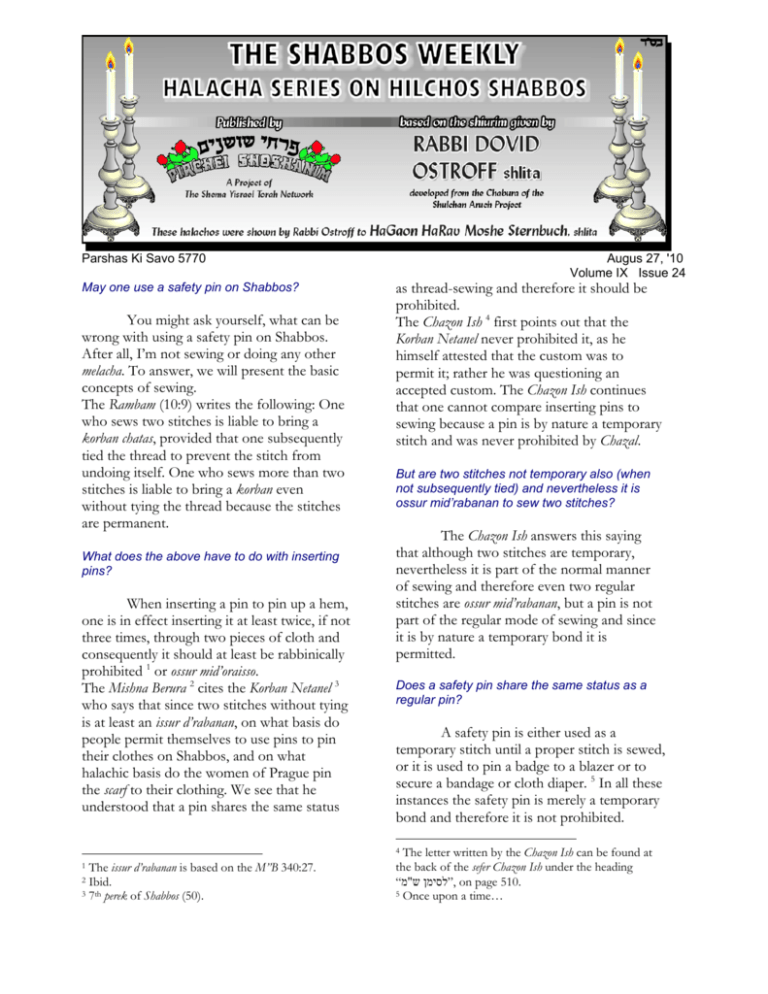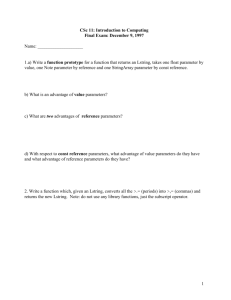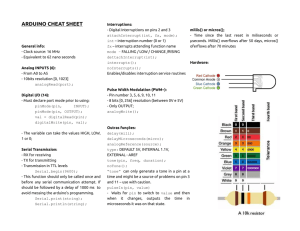You might ask yourself, what can be wrong with using a safety pin
advertisement

Parshas Ki Savo 5770 May one use a safety pin on Shabbos? You might ask yourself, what can be wrong with using a safety pin on Shabbos. After all, I’m not sewing or doing any other melacha. To answer, we will present the basic concepts of sewing. The Rambam (10:9) writes the following: One who sews two stitches is liable to bring a korban chatas, provided that one subsequently tied the thread to prevent the stitch from undoing itself. One who sews more than two stitches is liable to bring a korban even without tying the thread because the stitches are permanent. What does the above have to do with inserting pins? When inserting a pin to pin up a hem, one is in effect inserting it at least twice, if not three times, through two pieces of cloth and consequently it should at least be rabbinically prohibited 1 or ossur mid’oraisso. The Mishna Berura 2 cites the Korban Netanel 3 who says that since two stitches without tying is at least an issur d’rabanan, on what basis do people permit themselves to use pins to pin their clothes on Shabbos, and on what halachic basis do the women of Prague pin the scarf to their clothing. We see that he understood that a pin shares the same status The issur d’rabanan is based on the M”B 340:27. 2 Ibid. 3 7th perek of Shabbos (50). 1 Augus 27, '10 Volume IX Issue 24 as thread-sewing and therefore it should be prohibited. The Chazon Ish 4 first points out that the Korban Netanel never prohibited it, as he himself attested that the custom was to permit it; rather he was questioning an accepted custom. The Chazon Ish continues that one cannot compare inserting pins to sewing because a pin is by nature a temporary stitch and was never prohibited by Chazal. But are two stitches not temporary also (when not subsequently tied) and nevertheless it is ossur mid’rabanan to sew two stitches? The Chazon Ish answers this saying that although two stitches are temporary, nevertheless it is part of the normal manner of sewing and therefore even two regular stitches are ossur mid’rabanan, but a pin is not part of the regular mode of sewing and since it is by nature a temporary bond it is permitted. Does a safety pin share the same status as a regular pin? A safety pin is either used as a temporary stitch until a proper stitch is sewed, or it is used to pin a badge to a blazer or to secure a bandage or cloth diaper. 5 In all these instances the safety pin is merely a temporary bond and therefore it is not prohibited. 4 The letter written by the Chazon Ish can be found at the back of the sefer Chazon Ish under the heading “”לסימן ש"מ, on page 510. 5 Once upon a time… Rav Moshe Feinstein ztz”l writes 6 that one who wishes to be stringent should apply the stringency in a case where the safety pin or pin could be left permanently in the clothing (pinning a hem or a tear in one’s clothing), but when pinning something in a temporary way such as where it has to be freed, such as the safety pin in the diaper, there is no room for stringency at all. Other poskim 7 grant the Korban Netanel more authority and say that one should only be lenient when fixing temporarily with a safety pin (or pin) but when fixing on a more permanent basis one should not insert the pin in each piece of cloth more than once. 8 May one staple papers together or remove the staples that are fastening two papers together? Even if we say that a safety pin is not the regular sewing mode, we cannot say this with regards to paper, as it is normal to bind papers together by stapling. 9 Therefore one may not staple or remove staples. Rav Shlomo Zalman writes that one may not staple pages together even for less than the entire Shabbos because it is an עובדא דחולto use a stapler. Is it permitted to inflate balloons and airbeds on Shabbos? The halachic issue pertaining to inflating a waterbed on Shabbos is one of Makeh B’patish – completing an article. The Shulchan Aruch 11 teaches us that one may reinsert down (feathers and fluff) into a pillow and eiderdown but they may not be inserted for the first time. Even though the insertion does not entail physical force or any unique expertise, nevertheless it is a melacha called Makeh B’patish. This is because the combination of the pillow and the stuffing form a k’li. We can therefore deduce that combining two items to form a k’li will involve the issur of Makeh B’patish. Accordingly, it is prohibited to inflate a water or air bed, even when using a mechanical pump, because introducing the air or water into the bed “completes” the bed and transforms it into a usable k’li. [For the moment we are referring to the initial inflating of the water bed (the first time), as for consecutive inflating we will see further on be”H]. The same could be said when inflating helium balloons. May one open an envelope that is stapled shut? Rav Shlomo Zalman says it is muter to remove the staple in this case because it is only stapled temporarily – until opened by the addressee. 10 אגרות משה או"ח ח"ב סי' פ"ד. Rav Vozner in Shevet Halevy vol. IV simon 35 and others. 8 It is customary to use a safety pin, at least for temporary binding, and for a final ruling one must ask one’s rav. 9 SS”K 28:5 and footnote 17. 10 Rav Shlomo Zalman in the SS”K 9:9 and footnotes 34-35. 6 7 Orchos Chaim LaRosh אל יוציא שם שמים לבטלה ולא במקום מטונף- Do not utter Hashem’s name in vain or in an unclean place. Hashem’s name is holy and is His Torah, and it is forbidden to discuss, learn or think Torah in a halachically unclean place. The message behind this halacha is to forever endear the Torah and not sully it, just because we live and experience it every day, all day. It must remain G-d’s Torah and must be treated with the utmost dignity it deserves. 11 Simon 340:8. One may receive and distribute these weekly shiurim by calling or writing: Office 99 Rechov Bayit Vegan,Yerushalayim, Phone Numbers: U.S. and Canada 732-370-3344 Israel 972-3-616-6340 South Africa 076 187 1451 UK 44-020-8731-6666 Australia 61-296835626 Switzerland 0114143 333 0288 • e-mail: shabbosweekly@shemayisrael.com, or www.shemayisrael.com, weekly sponsorships are available as well. If you would like to send a question to Rav Ostroff, you can write to him at shabbosweekly@shemayisrael.com. Note: The purpose of this series is intended solely for the clarification of the topics discussed and not to render halachic decisions. It is intended to heighten everyone's awareness of important practical questions which do arise on this topic. One must consult with a proper halachic authority in order to receive p'sak.




